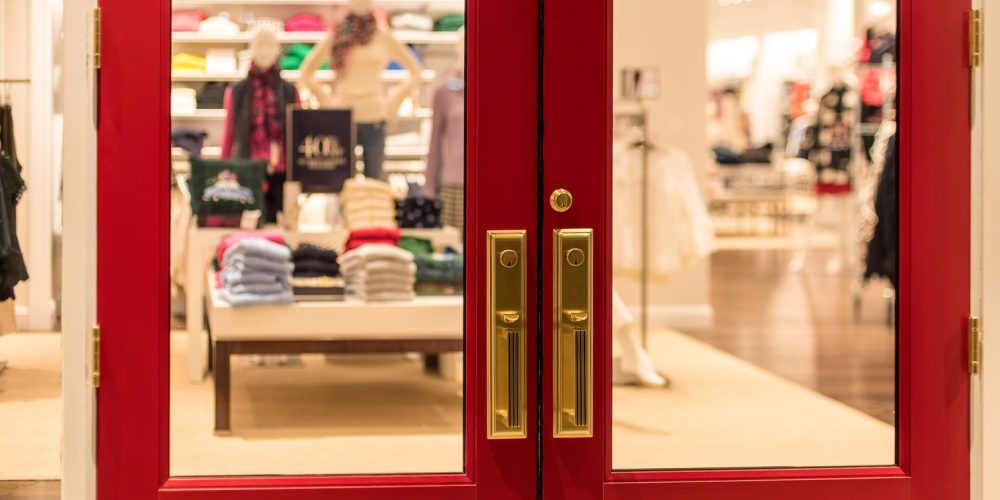8 Retail Industry Trends We Expect to See in 2022

The retail industry is constantly shifting and evolving which has birthed a handful of new retail industry trends. As technology continues to expand at a rapid rate, so does the industry. We have seen new innovations enter the field that have streamlined and improved processes. We’ve also seen drastic shifts in consumer behavior due to the COVID-19 pandemic.
Although we can’t predict exactly what 2022 will bring, we can make an educated guess based on some of the retail industry trends that have emerged just this past year and we foresee continuing to develop into the future.
1) A Shift to Online Shopping
One of the biggest retail industry trends we’ve seen emerge over the past few years is an increase in online shopping. This shift in consumer buying patterns had already been underway, but the pandemic accelerated the process, forcing retailers to innovate or fall behind. Chances are, if you weren’t able to transfer your business online then you probably took a pretty significant hit this past year.
Not only have consumers been spending more time online, but they have also been spending more money. During the shutdown, many people were forced to stay home and not partake in social activities such as dining out, going to shows, traveling, etc. This resulted in extra spending money that many consumers chose to allocate towards online shopping.
We predict that this shift toward online shopping is going to continue throughout the next year and for many more years to come. One of the best things retailers can do for their business right now is to invest and build a successful online platform because this “trend” is quickly becoming a way of life.

2) Store Closures
This retail industry trend piggybacks off the previous point in that many stores were forced to shut down during the height of the pandemic. For many retailers business was halted or even completely derailed, depending on their state of affairs before the shutdown. Many businesses had to make tough decisions when it came to re-opening their brick and mortar locations. Unfortunately, there were a lot of retailers who weren’t able to weather the storm and had to close their doors permanently.
A report by Real estate data tracker CoStar stated that 40 major retailers declared bankruptcy in 2020, and more than 11,000 store closures were announced. The one exception to this trend is the dollar store sector which is currently undergoing expansion. Dollar stores accounted for half the store openings in the US in 2020. In fact, Dollar General recently announced that they’ve made it their goal to add around 1,050 locations within the next year.
Related: Datalogic 4500 Handheld Scanner
Many retailers are hopeful that store closures are a trend that will stay lodged in the past. Although we are hopeful as well, we caution these retailers to take a precautionary instead of a reactionary stance by making adaptations to weather another pandemic as best they can. As much as we’d all like to “return to normal”, it’s predicted that store closures will continue into the next year.
3) A Shift in Consumer Expectations for Shipping & Delivery
This retail industry trend is another one that has been evolving over time but is especially relevant today. We live in the era of convenience and instant gratification and this mentality has leaked into the world of retail. Consumers expect goods to be shipped quickly and effectively. This hasn’t been as much of an issue for big retailers such as Amazon that have the infrastructure and capacity to handle mass shipments, but even still they’re experiencing issues with lack of warehouse space and worker shortages.
Unfortunately, these consumer expectations are at odds with the fulfillment issues that many retailers have been battling this past year. The pandemic has caused a worldwide shipping crisis which has impacted many retailers across the globe. So far, we’ve seen some improvement in the global market, but there’s no guarantee that things will continue to trend upwards. The best plan of action for retailers is to continue to adapt as best they can to the current shipping and delivery conditions in the industry.
Another way to adapt to consumer expectations is to offer free shipping or free shipping incentives. According to a study conducted by Influencer Marketing Hub, 24% of consumers admit that they would spend more to qualify for free shipping. They also found that companies with free shipping have a 20% higher conversion rate than those without this option.
4) Remote Work + Worker Shortages
Another side effect of the pandemic is the rise of remote work opportunities. Many people have conflicting views on whether this is a negative or positive shift, but no matter your viewpoint, it’s clear that it has become a permanent part of our “new normal”. When it comes to the retail industry specifically, retailers have started to offer remote work opportunities to certain groups of employees that are feasibly able to make the shift. This has changed the way in which certain retailers conduct business and has forced them to create new processes.
Alongside the shift to remote work, there have also been worker shortages. Some retailers have refused or simply can’t shift to a remote work environment due to the nature of their business. For these retailers, some have experienced worker shortages due to their employees finding other opportunities or simply not wanting to return to work. This has put more strain on their existing employees to make up for the shortages by taking on extra or longer shifts.
As we head into 2022, it’s expected that this shift to remote work will continue to take hold and retailers are encouraged to adapt their work environment accordingly. For those who aren’t able to make these adaptations, they must find other ways to attract workers such as good benefits, competitive pay, or a high-quality working environment.

5) Brick and Mortar Infrastructure Changes
For those who have chosen to keep their brick-and-mortar locations open and fully operational, there are some important infrastructure changes that will need to be made. According to Deloitte’s “Global State of the Consumer Tracker”, they found that 42% of U.S consumers feel safe enough, from a health-risk angle, to return to physical retail stores. That’s a significant improvement from about 34% of U.S. consumers who said the same thing in late April. However, that still leaves a large percentage of American consumers who are still hesitant to return to in-person shopping.
The best way for retailers to help consumers and their employees feel safe in their stores is to make a few infrastructure changes including social distancing markers, plexiglass guards at cash registers, strict cleaning regiments, contactless payments, etc. As an advanced technology repair company, we’ve noticed a shift away from static POS counters to using mobile payment systems.
Related: Honeywell CK65 Mobile Computer
We feel that this shift towards increased safety measures is a positive trend as it has forced retailers to find new and innovative ways to combat the spread of germs in their stores. This has had a major impact on decreasing the spread of COVID-19 along with other harmful viruses such as the flu.
6) An Increase in The Use of Social Media
When it comes to retail industry trends in 2022, this is a big one. Now that a good chunk of the population is working remotely and continuing to limit in-person interactions, it only makes sense that social media usage would increase. Many people use social media as a way to connect and communicate with their friends, family, and favorite brands. With this being said, it’s more important than ever for retailers, both big and small, to have a presence on social media.
Providing advice on exactly how to have a “presence” on social media is a rabbit hole we don’t want to dive too deep into, but the most important thing is to make sure you have an account on the major platforms (Facebook, Instagram, Twitter, YouTube, etc.) and are actively engaging with your audience. Oftentimes consumers will inquire about products or ask questions via their social media accounts. This is yet another way for retailers to serve and interact with consumers.
As a retailer, social media is no longer an option. If you want to stay relevant and keep up with your competition, now is the time to start formulating a social media strategy and posting content to set yourself up for success in 2022.

7) Sustainability Initiatives
Pandemic aside, the other global crisis we must come to terms with is the threat of climate change. Consumers are becoming more and more eco-conscious and are opting for sustainable options. In a 2019 Global Consumer Insights Survey conducted by strategy+insight magazine, 35% of respondents said they chose sustainable products to help protect the environment, 37% said they looked for products with environmentally friendly packaging, and 41% said they avoided the use of plastic when they could.
Related: NCR RealPOS XR7 Touch Terminal
This shift in consumer behavior means that retailers feel a heightened pressure to engage in sustainable practices. This may look a little different for each retailer, but the consensus is that these adaptations need to be made in order to stay relevant and competitive. We expect this trend to continue to gain momentum in 2022 and in many years to come.
8) AI Integrations
One of the last retail industry trends we want to touch on is advancements in AI that have been making waves in the retail industry. There have been huge advancements in inventory management and customer engagement/support. Retailers are now able to access real-time global visibility across all of their inventory and improve service levels to maximize OTIF performance. There have also been strides made in the customer experience and service sectors such as interactive web flows, journey mapping, and improved virtual chat.
We’ve also witnessed the emergence of innovative tools such as adaptive homepage, dynamic outreach, interactive chat, visual curation, guided discovery, conversational support, and more. We’re encouraged to see such groundbreaking innovations emerge in the industry within just this past year and we’re certain that there are more advancements just around the corner. We’re excited to see what new tools and process improvements 2022 will bring.
Retail FAQs
What Is The Future Of Retail Industry?
In 2022, worldwide retail eCommerce sales will exceed $5 trillion for the first time, accounting for more than a fifth of overall retail sales. Growth in eCommerce retail over the next few years will slow down due to in-store retail’s rapid bounceback.
How Is The Retail Industry Changing?
Retailers are taking on larger players by moving online Today, shoppers make 43% of their monthly retail purchases online, and retailers are meeting those needs, with 88% now selling online. As many retailers are changing their business models, going online increases the odds of success.
How Is Retail Doing In 2022?
Retail sales are expected to grow between 6% and 8% in 2022, as consumers spend more on services instead of goods and cope with inflation, the National Retail Federation said on Tuesday. That annual forecast represents a slower pace of growth for retailers than 2021, but it's higher than the pre-pandemic growth rate.
Is The Retail Industry Growing Or Declining?
Retail sales grew on average 3.7% annually from 2010-2019. As we emerge from the global pandemic, retail is growing at levels not seen in over 20 years. Retail sales grew by 7% in 2020 and by over 14% in 2021. NRF forecasts that sales will grow by between 6% and 8% to more than $4.9 trillion in 2022.